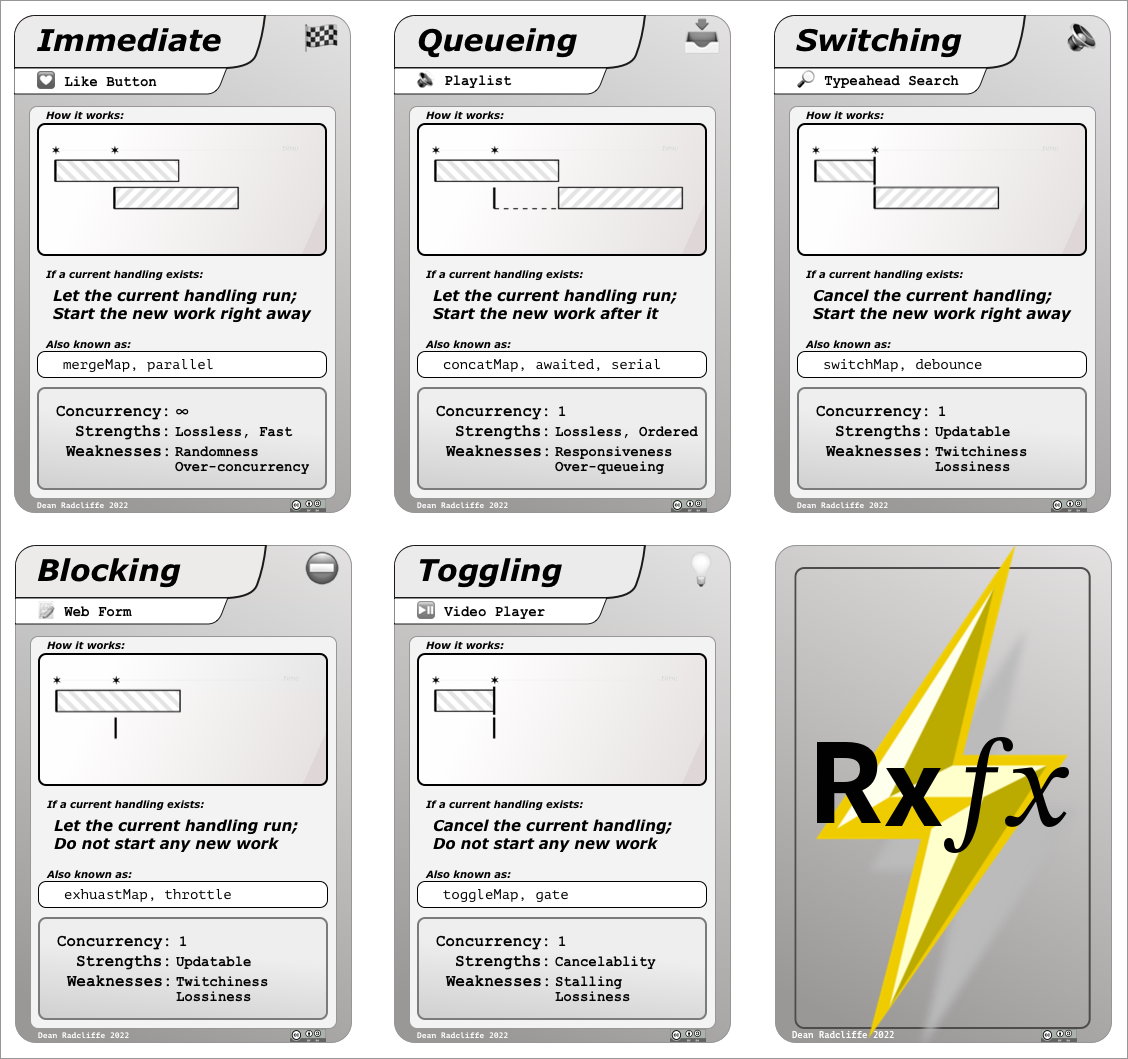Read the fine docs at: https://rxfx.gitbook.io/docs/, or in the READMEs of the libraries below.
If you just want some free printable cards to help remember RxJS Concurrency operators, scroll to Concurrency Modes
𝗥𝘅𝑓𝑥 is effect and state management made simple, safe, and framework independent. Implemented as a family of libraries, the primary of which are @rxfx/service and @rxfx/effect and @rxfx/bus
Install like this:
npm install -S @rxfx/service
A bus calls your function in Pub-Sub style, where the trigger-er doesn't know about listeners. An effect is like a higher-order function, providing benefits vs a direct call. A service builds upon an effect, tracking state, and using a namespace for logged lifecycle events
The main call styles are shown, for the example of calling a function called playBellAudio which returns a Promise or Observable:
// Bus
import { defaultBus as bus } from '@rxfx/bus'
const RING = createEvent<void>("bell/ring");
bus.listen(RING, () => playBellAudio) // or bus.listenQueueing
bus.trigger(RING())// Effect
import { createEffect } from '@rxfx/effect'
const ringEffect = createEffect(playBellAudio) // or createQueueingEffect
ringEffect()// Service
import { createService } from '@rxfx/service'
const ringService = createService("bell", playBellAudio)
ringService.request();See the individual libraries for more.
-
@rxfx/service- UI Framework-independent effect manager and state manager, ala NgRx, Redux Saga, or Redux Toolkit. Execute and cancel effects, and provide reactive state changes on their lifecycle events. -
@rxfx/effect- UI Framework-independent effect execution, progress notification and cancelation - a subset of@rxfx/servicefocused on effects, not state. -
@rxfx/bus- A Low-level effect execution and event observation with ordering, concurrency, and error isolation. -
@rxfx/reactHooks for using bus or listeners, or general RxJs Observables inside of React Components. -
@rxfx/afterA utility for introducing delays, or creating scripts of delays. -
@rxfx/perception- Constants and functions related to human response times and perception thresholds of our various senses. -
@rxfx/animation- A TypeScript/Observable version of TweenJS. -
@rxfx/fsa- A re-publish of https://github.com/aikoven/typescript-fsa -
@rxfx/operatorsA collection of supplemental RxJS operators. -
@rxfx/ajaxfetchMany- gives you a Streaming Observable of a plural endpoint (e.g.users/) instead of the all-at-the-end delivery of Promises. (Is Cancelable too). -
@rxfx/peer- Can help a mesh of peers coordinate a single LEAD, even as peers come and go.
30 years after setTimeout introduced the world to the asynchronous nature of JavaScript, effect execution is still clumsy at best, and broken in many cases. And none of the popular front-end solutions (Angular, React, RxJS) present a complete solution that deals with all the concerns of async effects in a framework-independent way.
- Error handling that is predictable, and does not compromise the integrity of the app the more effects you add.
- Automatic
loading/activestate tracking. - Automatic tracability of all lifecycle events of effects (
started,next,complete,error,canceled, etc.) - Simple effect cancelation from anywhere inside or outside the component tree.
- Seamless interopation with Promises, Observables, Iterables and generators.
- Easily reduced or adjustable concurrency (immediate, queueing, throttling, etc) without introducing complication or additional variables.
An 𝗥𝘅𝑓𝑥 service (or a bus) is a view-framework-independent, pure JS container for Effect Management and State Mangement, based on RxJS. An 𝗥𝘅𝑓𝑥 Service supports all the above pain points in an easy API.
- You notice you are introducing
loadingstate fields which must be set and unset manually - You are manually outputting logging messages, and there is no standard convention between them.
- You are using framework-specific constructs (
useEffect, async pipe) to manage asynchrony. - You want a better separation of the View Layer from the async layer.
- You are dealing with race conditions
- You are using RxJS, but want fewer imports and operators, and you're feeling it clumsy to manage subscriptions in addition to Observables.
- You are using React, and want to heed the warnings in their docs about
useEffectbeing used often in the wrong ways. - You are tired of async errors breaking the view layer, or the app as a whole, as more effects get added to your app.
- You find tests take too long to run when they have to be called through the view layer, and you want something that is testable independent of the view.
In short - if you believe there is a more concise, more airtight, race-condition-proof way to do async, you may have found it right here in an 𝗥𝘅𝑓𝑥 service or bus listener.
Race conditions are easily prevented when code is set to run in the correct Concurrency Mode for its use case. With 𝗥𝘅𝑓𝑥, its easily named and tested modes (which use RxJS operators underneath) allow you to keep your code readable, and you can eliminate race conditions in a 1-line code diff.
Choose your mode by answering this question:
If the effect is running, and a new request arrives, should we:
- Begin the new effect at once, allowing both to finish in any order. (Immediate mode, ala
createService) - Begin the new effect only after any currently running effects, preserving order. (Queueing mode, ala
createQueueingService) - Prevent/throttle the new effect from beginning. (Blocking mode)
- Cancel the currently running effect and begin the new effect at once. (Switching mode)
And one final mode, seldom used, but included for completion:
- Cancel the currently running effect, and don't begin a new effect. (Toggling mode)
Here are representations of each mode:
